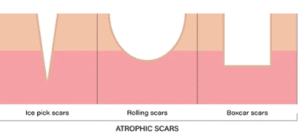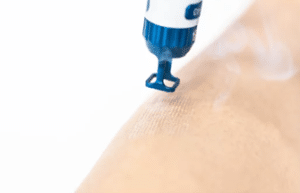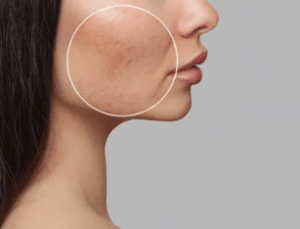Atrophic acne scarring
What is it?
Atrophic scarring is a common and unfortunate result of pimples. There are 3 types of atrophic acne scarring: ice pick, boxcar, and rolling. These scars can have a significant impact on an individual’s quality of life. Treatment for atrophic scarring may vary depending on the type of scar we are treating. In saying that, we would highly recommend combination treatments to achieve the best outcome from treatment. Book with our Dermal Clinician on HotDoc for an assessment of your acne scarring.
When it comes to treatment your dermatologist or dermal clinician will educate you on the best treatment modality for you, depending on the type of atrophic scar present. Generally speaking, the treatments we utilise are, Co2 ablative laser, TCA cross, skin needling, subcisions, vascular laser (if there is any erythema), and chemical peels. The ideal treatment plan would be to use combination therapy; this is when we are using more than one treatment to achieve the desired end result. Combination therapy may also allow us to see improvement quicker. For example, a patient with ice pick scarring may be on a treatment plan such as: x 2 sessions TCA cross 6 weeks apart, a nd x 3 Co2 ablative laser 6 weeks apart. As mentioned, this is just an example. Each individual may require a unique treatment plan.
nd x 3 Co2 ablative laser 6 weeks apart. As mentioned, this is just an example. Each individual may require a unique treatment plan.
What are the treatments?
TCA Cross
Trichloracetic acid (TCA) is a liquid that causes protein denaturation when applied to the skin. When this process happens, it creates a pronounced white frost on the skin. TCA is the ideal first treatment for ice pick scarring; due to the deep hollow nature of an ice pick scar. The TCA is applied very precisely into the ice pick scar using a very thin wooden stick. When the TCA is applied to the bottom of the scar it stimulates new collagen in the healing phase; meaning when the scar heals it will fill up and become more superficial; making the scar more even and improving overall look of skin complexion!
Ablative laser
Ablative lasers utilise energy at 10.600nm wavelength. This energy gets absorbed by water that sits outside and inside of the cell, causing rapid dermal heating and vaporisation of the tissue. When this dermal heating is created it induces a wound healing response, resulting in collagen remodelling. So, in effect, this causes the scar to “shrink” and we see a more even and clear skin complexion. Downtime post ablative lasers may include swelling, redness, flaky skin, and tenderness. Healing of the new skin generally takes 5 to 10 days.
Skin needling
Skin needling is referred to as collagen induction therapy and is seen as the gold standard for treating scarring. There are different skin needling devices such as skin pens, skin needling rollers, and skin needling stamps. Generally speaking, they all provide a level of skin rejuvenation. Skin pen devices can be set at deeper depths, this allow us to target the second layer of skin (the dermis), which is what we aim for when treating scarring. With skin needling pens we want to see some bleeding and erythema (redness), which ultimately initiates the complex cascade of growth factors that results in beautiful new collagen production.
Subcision
Subcision is a procedure in which a needle is inserted under the skin and passed in multiple directions. Subcision is best for rolling acne scars that would generally have normal quality of skin at the base of the scar unlike boxcar and ice pick scar. When the needle is inserted under the skin it releases the tense strands that are underlying the scars. This then reorganises the connective tissue formation in that area, creating a softer and more superficial scars.
https://www.ncbi.nlm.nih.gov/pmc/articles/PMC5749614/
https://www.ncbi.nlm.nih.gov/pmc/articles/PMC4445894/
The post Acne scarring – assessment and treatments appeared first on Hope Dermatology.







